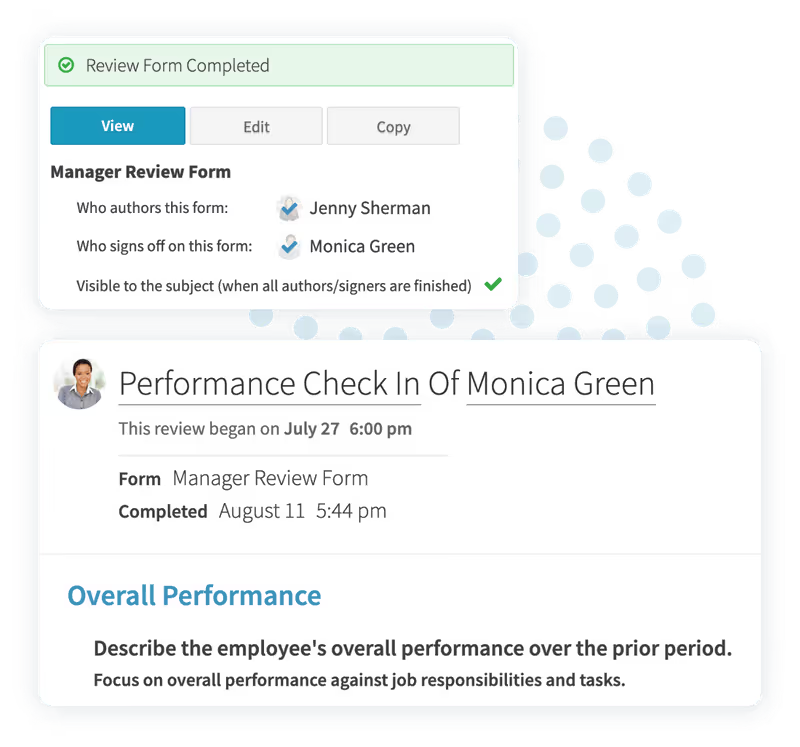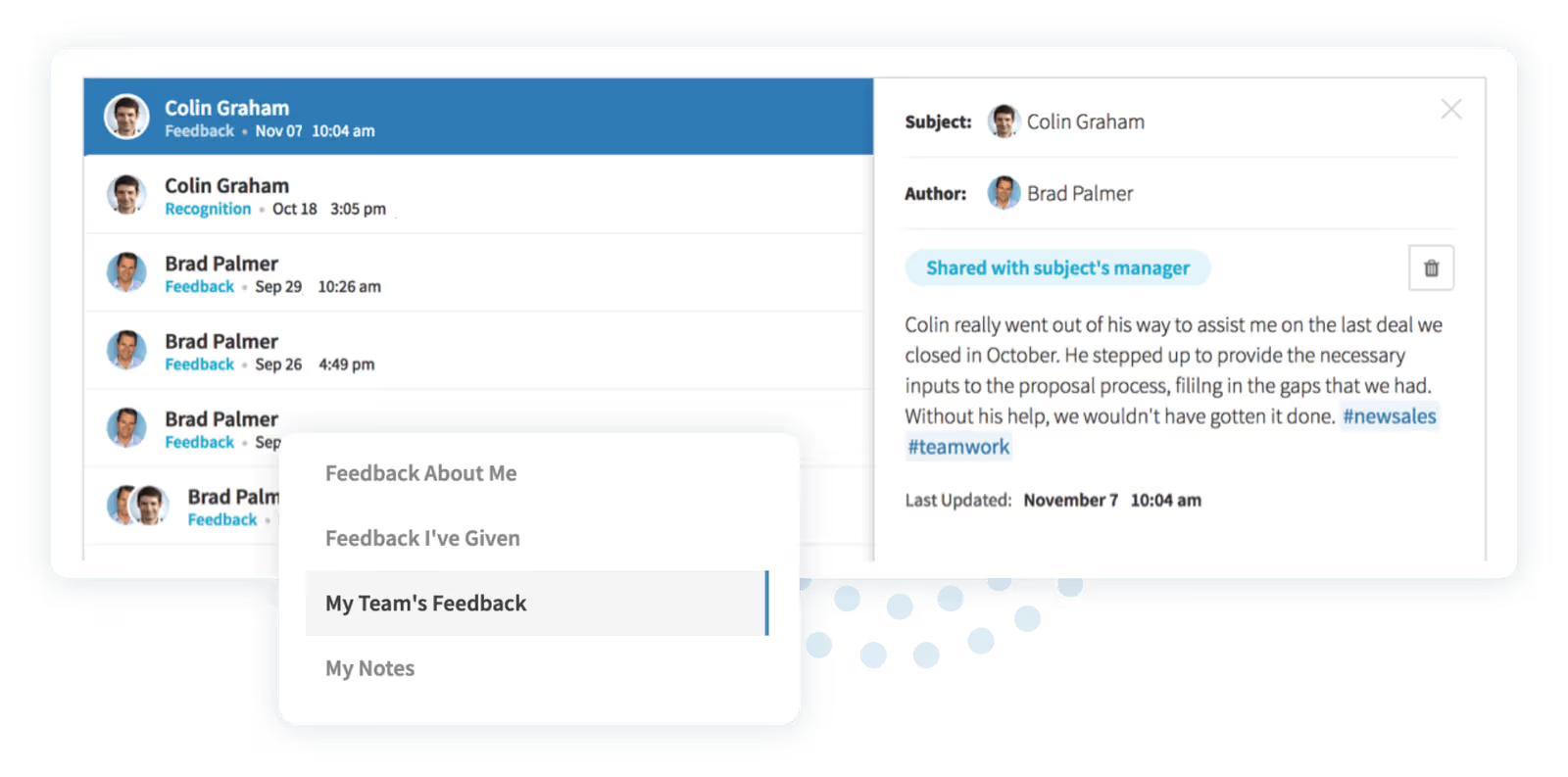Values-Based Performance Review Template | Guide and Tips
In this article you'll learn how to conduct values-based performance reviews. We'll also provide a free template to use during the review process.
Free Values-Based Performance Review Template
Why Values-Based Reviews Matter
Values-based reviews are an excellent way to examine an employee’s performance relative to a company’s chosen values. These reviews reinforce the values that your company wishes to uphold. Using these reviews creates a more ingrained company culture.
A company culture based on shared values is proven to be beneficial for increased productivity. Data from Harvard Business Review shows that positive workplaces have 33% less healthcare spending and less turnover. Positive company culture boosts engagement, leading to more satisfied employees and clients.
Companies have started to understand that positive company values boost worker health and productivity. These same businesses are now incorporating company values into performance reviews. This process helps HR and leadership see how productive an employee has been and how they are contributing to a positive working environment.

Determining your company’s core values
Determining your company’s core values should be a thoughtful process that has the buy-in of the entire leadership team. It must not only reflect the vision of the executive team but also be embraced by your whole workforce.
Your executive team may think, “working from 9 am to 11 pm will make us way more productive, let’s make ‘working late’ a core value.” However, your workforce may think, “yikes, it’s time to find a new job!”
So, how should you determine your company’s core values?
Examine what values your company already holds
This is a great first step and a way to get input from your entire workforce. Set up a series of workshops and small group meetings. Ask for honest feedback about values.
- What values do your employees hold?
- What values do they believe the organization embodies?
- What values do they believe the organization should hold
- Distill the findings into a series of values that represent where your organization currently is.
Determine where you wish to be
If your company already has a strategic vision for the future, this is a great time to revisit it. If not, it’s time for you and your leadership to determine where you wish to be in one year, five years, or ten years.
- What do you wish to accomplish?
- Who do you wish to be?
- How do you want to be defined?
See how your current values match up with your vision
Do the values your company currently embodies allow you to reach your goal?
Do some of them?
Figure out which existing values are helpful, which values are not supporting your mission, and which values you need to add.
Define your values, and stick to the minimum necessary to achieve your vision
Articulate the meaning of each value and define associated behaviors. This will help employees understand what their work and behavior should embody.
For example, “positivity” may be understood by a manager to be “up for taking on additional work.” An employee may understand positivity as “showing up to work with a smile.” Your workforce needs to be on the same page.
Stick to as few goals as possible. If you can do the work of 10 goals in 5, do 5. If you can do the work of 5 in 3, do 3. This will enhance focus and commitment to the most critical goals, rather than spreading focus around until the values are watered down.
» Free OKR Template & Examples for Goals, Planning, Reporting
Examples of Core Values in a Performance Review
So what are some examples of core values that your organization can adopt and then incorporate into the performance review process?
Let’s take a look at some popular choices. Each value must have corresponding actions that employees can take to embody these values in their daily work. Understand that not every value will be right for each organization.
Choose the values that reflect your vision and culture, Remember to also keep the number to the minimum number needed to achieve your vision -- we find that 5 is a good starting point.
- Customer Service - Employees respond quickly to client requests, act appropriately, adapt to customer feedback, and create strong relationships.
- Respect - Employees validate their client’s problems and their coworker’s ideas, keep an open mind, and are professional in work settings.
- Positivity - Employees identify solutions when presented with problems, strive to find progress every day, and encourage their colleagues to overcome obstacles.
- Creativity - Employees provide innovative solutions, brainstorm effectively, and support an atmosphere of creativity.
- Leadership - Employees take ownership of their mistakes, lead colleagues by example, and manage conflict in constructive ways.
- Quality - Employees meet expectations for their job output make few mistakes and complete work on time.
- Integrity - Employees do not lie or mislead colleagues, they do not cut corners, and have open and appropriate communication with colleagues.
- Hard work - Employees are present, work to exceed expectations, and push themselves to be more efficient.
- Initiative - Employees work to solve problems before they are asked, are aware of client needs, and meet them proactively.
Using Core Values in Performance Reviews
Once you have determined your company’s core values, you need to determine how they will be used in the performance review process.
Incorporating values into the performance review process provides an additional dimension to an employee’s performance. You can move beyond asking “did they accomplish their goals,” and onto asking, “is this employee cultivating a productive working environment that improves office wellbeing?”
This additional dimension needs to be addressed in the review process. Getting this right may take some extra effort, but it goes a long way to creating a positive working environment.
Here are the best ways to incorporate values into the performance review process.
- Rating each value - When values are rated on a scale, you get quantitative feedback as to whether your employees are meeting expectations and demonstrating company values.
- Qualitative examples of values in action - Reviewers provide examples of when employees demonstrated certain values over the review period. This method lets each employee know exactly what behaviors contributed to each value.
- Values as Goals - To help bring values into the performance review organically, you can develop goals into core values. An employee’s goal can be to “embody quality in the workplace by achieving a 98% accuracy record.” This way, core values become a necessary part of your employees’ work, and employees can see how their work helps contribute to positive company culture.
How should values be evaluated in performance reviews?
There are three main avenues for feedback in performance reviews:
- Top-down
- Peer
- External
Top-down feedback is where a manager provides feedback on a direct hire’s performance. This is the traditional model of feedback and is commonly used across all organizations.
Peer feedback is where your employees’ peers and colleagues provide feedback, typically in addition to manager feedback. This is most commonly seen in 360 reviews, where a holistic review of an employee is completed each review cycle. 360 reviews are very helpful in understanding how employees function within a greater organization.
External feedback is commonly used for client-facing employees. With external feedback, feedback is solicited from your clients themselves. This is very helpful in seeing how your employees embody your values as ambassadors for your organization.

Example Values-Based Feedback
Positive Feedback Examples
- Customer Service: Your responsiveness and dedication to client satisfaction have been exceptional. You consistently go above and beyond to address customer needs, greatly enhancing our reputation for outstanding service.
- Respect: You consistently demonstrate a high level of respect towards both clients and colleagues. Your professional demeanor and ability to value diverse perspectives contribute significantly to a positive and inclusive work environment.
- Positivity: Your positive attitude and resilience, especially under challenging circumstances, are commendable. You always manage to find solutions and motivate others, fostering a constructive and optimistic team atmosphere."
- Creativity: Your innovative approach to problem-solving has led to groundbreaking ideas and improvements in our processes. Your creativity not only sets a high standard but also inspires your peers to think outside the box.
- Leadership: Your leadership skills are evident in your ability to guide your team through complex projects. You demonstrate ownership of your decisions, provide clear direction, and effectively manage conflicts, setting a strong example for others.
Critical Feedback Examples
- Customer Service: There's an opportunity for you to enhance your customer service skills. Increasing your responsiveness and showing more adaptability to client feedback could greatly improve client satisfaction and loyalty.
- Respect: While your technical skills are commendable, focusing more on showing respect in your interactions could improve team dynamics. Being more open to others' ideas and maintaining professionalism in discussions will strengthen team collaboration.
- Positivity: Adopting a more positive outlook, especially during challenging times, could enhance your work experience and that of your colleagues. Focusing on solutions rather than problems will contribute to a more productive and positive team environment.
- Creativity: Encouraging more creative thinking in your approach to tasks can lead to more innovative outcomes. Consider exploring new perspectives and brainstorming with your team to foster a more creative working atmosphere.
- Leadership: Developing stronger leadership qualities, such as more effective communication and proactive conflict resolution, could enhance your team's performance. Focusing on leading by example and owning up to mistakes will build greater trust and respect among your peers.
How can you manage values-based performance reviews?
The easiest way to manage performance review forms is through a performance management system like PerformYard.
PerformYard provides a single sign-on software that centralizes every aspect of the performance review process. That includes goal setting, review forms, kickoff, and performance analysis.
PerformYard provides a flexible system that lets you tailor the review process to your needs. You can input your core values to create a unique values-based performance review. This review will help your company make effective decisions for your future.
If you're interested in streamlining your performance management process (including values-based reviews), click here.
We’ll show you how PerformYard helps you creates the performance review process that works for your organization.
More Questions About Values-Based Performance Reviews
- How do I decide what my organization’s core values are?
Decide what you want your organization to be known for, both internally and externally, and the values you want your employees to personify in their work. Finally, think about the workplace culture you want to achieve through those values. For inspiration, here are 11 types of real-world high-performance company cultures.
- How can I determine if my employees are exemplifying our core values?
Come up with a list of behaviors that embody each value so all employees are on the same page.
- What is a good core value?
A good core value is authentic to your organization, easy to remember, and has measurable behaviors.
- Can I use the mission statement as our core values?
Core values should go beyond your mission statement. A mission statement is typically a high-level aim for the organization while core values are principles and corresponding behaviors that support your mission.
- How can I begin to foster core values?
Establishing clear expectations of behavior and modeling said behavior will guide employees toward the values you want to cultivate.
- How can I rate core values in my performance reviews?
Using Behaviorally Anchored Rating Scales is a great way to rate a qualitative measure like values. BARS assigns numerical values to specific behaviors and actions that an employee will complete.
For example, if an employee has to answer the telephone frequently for work, they may receive a BARS value of 4 for answering the telephone after 2 rings, but a BARS value of 6 for answering it after only 1 ring.
By using BARS, you can define expectations you have for behaviors that encompass specific core values, and then you can measure how well your employees meet and exceed these expectations.



.jpg)

